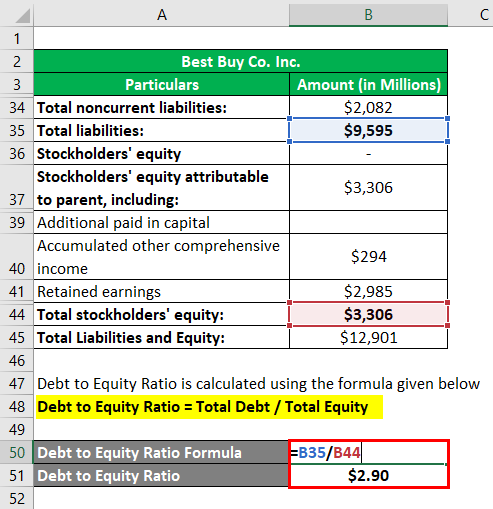
A higher ratio may deter conservative investors, while those with a higher risk tolerance might see it as an opportunity for greater returns. As established, a high D/E ratio points to a company that is more dependent on debt than its own capital, while a low D/E ratio indicates greater use of internal resources and minimal borrowing. Ultimately, the D/E ratio tells us about the company’s approach to balancing risk and reward.
What is a Good Debt to Equity Ratio?
In other industries, such as IT, which don’t require much capital, a high debt to equity ratio is a sign of great risk, and therefore, a much lower debt to equity ratio is more preferable. In the financial industry (particularly banking), a similar concept is equity to total assets (or equity to risk-weighted assets), otherwise known as capital adequacy. Attributing preferred shares to one or the other is partially a subjective decision but will also take into account the specific features of the preferred shares. In the majority of cases, a negative D/E ratio is considered a risky sign, and the company might be at risk of bankruptcy. However, it could also mean the company issued shareholders significant dividends. In general, if a company’s D/E ratio is too high, that signals that the company is at risk of financial distress (i.e. at risk of being unable to meet required debt obligations).
Limitations Of The Debt To Equity Ratio
Understanding the average Debt to Equity ratio in your industry helps contextualize your company’s financial standing. This comparison can inform strategic decisions regarding financing and growth. Debt to equity ratio is the most commonly used ratio for measuring financial leverage. Other ratios used for measuring financial leverage include interest coverage ratio, debt to assets ratio, debt to EBITDA ratio, and debt to capital ratio.
How confident are you in your long term financial plan?
- Together, the total debt and total equity of a company combine to equal its total capital, which is also accounted for as total assets.
- There also are many other metrics used in corporate accounting and financial analysis used as indicators of financial health that should be studied alongside the D/E ratio.
- Sometimes, however, a low debt to equity ratio could be caused by a company’s inability to leverage its assets and use debt to finance more growth, which translates to lower return on investment for shareholders.
- Your Annual Percentage Yield is variable and may change at the discretion of the Partner Banks or Public Investing.
It shines a light on a company’s financial structure, revealing the balance between debt and equity. It’s not just about numbers; it’s about understanding the story behind those numbers. This number represents the residual interest in the company’s assets after deducting liabilities.

Online Investments
A low D/E ratio shows a lower amount of financing by debt from lenders compared to the funding by equity from shareholders. The nature of the baking business is to take customer deposits, which are liabilities, on the company’s balance sheet. Like the D/E ratio, all other gearing ratios must be examined in the context of the company’s industry and competitors.
Which of these is most important for your financial advisor to have?
Some analysts like to use a modified D/E ratio to calculate the figure using only long-term debt. As an example, many nonfinancial corporate businesses have seen their D/E ratios rise in recent years because they’ve increased their debt considerably over the past decade. Over this period, their debt has increased from about $6.4 billion to $12.5 billion (2). It’s useful to compare ratios between top 4 tiers of conflict of interest faced by board directors companies in the same industry, and you should also have a sense of the median or average D/E ratio for the company’s industry as a whole. You can calculate the D/E ratio of any publicly traded company by using just two numbers, which are located on the business’s 10-K filing. However, it’s important to look at the larger picture to understand what this number means for the business.
The debt to equity ratio shows the percentage of company financing that comes from creditors and investors. A higher debt to equity ratio indicates that more creditor financing (bank loans) is used than investor financing (shareholders). The debt-to-equity ratio or D/E ratio is an important metric in finance that measures the financial leverage of a company and evaluates the extent to which it can cover its debt. It is calculated by dividing the total liabilities by the shareholder equity of the company. A company’s total liabilities are the aggregate of all its financial obligations to creditors over a specific period of time, and typically include short term and long term liabilities and other liabilities.
The D/E ratio is a financial metric that measures the proportion of a company’s debt relative to its shareholder equity. The ratio offers insights into the company’s debt level, indicating whether it uses more debt or equity to run its operations. The debt-to-equity ratio (D/E) is a financial leverage ratio that can be helpful when attempting to understand a company’s economic health and if an investment is worthwhile or not. It is considered to be a gearing ratio that compares the owner’s equity or capital to debt, or funds borrowed by the company. Basically, the more business operations rely on borrowed money, the higher the risk of bankruptcy if the company hits hard times. The reason for this is there are still loans that need to be paid while also not having enough to meet its obligations.
Leave a Reply